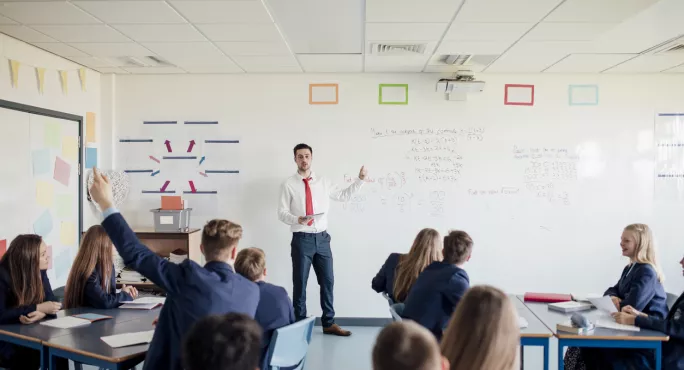New teachers: 10 ways to claim your classroom space

The first terms as an early career teacher are daunting: and it can be a while until you feel completely settled in your new role. But your classroom is the place you’ll spend the majority of your time, and it’s crucial that you feel ownership of it, as well as at home within it.
Many of you will have carried out a lot of your teacher training remotely - and therefore, may feel a little uncertain about how to claim classrooms as your own. Here’s my advice.
Behaviour: How early career teachers can take control of their classroom
1. Utilise the meet and greet to your advantage
Don’t allow rowdy behaviour past your threshold: ask the students who are messing around to step aside, and allow others into the class and greet them positively using as many names as possible.
Remember to personalise the interaction: if they were unwell during the last lesson, ask if they are feeling better. If they recently went on a trip, or played in a school football match, check how it went.
Once you’ve welcomed all the well-behaved pupils, turn to those you asked to wait, reset expectations and welcome them just as positively as you did everyone else.
The Early Career Framework: What you need to know
New teachers: How to build confidence in the classroom
More: Why new teachers need a good mentor more than ever
2. Seating plans
One of my greatest tools a teacher can have is a paper seating plan. I use mine for cold calling, and refer to it throughout the lesson when students ask for help so that I learn names quickly. If students need to be moved, update your copy there and then.
3. Practise the technology
My Teach First trainee and I spent a portion of the September Inset day acting out the start of the lesson - and checked things like connecting via HDMI, how to share screens, and if the sound worked. Continue to do this throughout the year: when things go wrong with the tech, make a note of it, and practise it before the next lesson.
4. Overcoming the stationery black hole
Classrooms are a black hole for equipment. Set out clear equipment rules in your room: will you provide it or should students bring the equipment with them? But remember, the longer students are without a pen and unsure on how to gain one, the more minutes of learning are lost.
5. Circulate
Moving around the room when students are on task is a great way to gain instant feedback on student progress. I always try to start with the more reluctant or quieter students first to ensure they have an opportunity to access individual support. Don’t underestimate how much a simple peer over a shoulder and praise can do for motivation.
6. The table tap
The silent table tap can work really well with students who are being disruptive or who are off-task. Without altering what you are saying, walk over to the student and tap their table to gain their attention. You can then point to the part in the reading, point to their book where the work should be, all without verbally communicating to avoid interrupting the flow for other students.
7. Positive framing
Alter your language to emphasise the positive actions of students to your advantage. Phrases such as “well done to the entire back row for having their pens down and waiting” rather than “I am waiting for 10 people in the middle of the room to have their pens down” flips the tone of the statement, while incorporating the expectation and instruction.
Personalise these phrases where you can - students get a buzz out of hearing their name individually praised.
8. Keep the behaviour policy close
It’s impossible to memorise all the different behaviour sanctions in the early days, and having the school behaviour policy at hand can alleviate this stress. I pin mine on the wall behind my desk and have no shame in scanning it in front of students.
If you’re ever in doubt of the sanction, be honest with students and say that you will be referring the incident to their head of year and will let them and their parents know the consequence of their actions in your classroom.
9. Transition between lessons
As your classes become more familiar with your routines, you can begin to utilise the three minutes between one lesson ending and the next beginning to prepare. If you’re teaching back to back, as one class packs up their books, fan out the next class’ books on the front desk. Once the students leave it should mean you can be at the door ready to repeat the meet-and-greet process.
10. Beyond the classroom
Actions outside the classroom can also benefit your ownership within it. Make sure you communicate with home, and for every negative phone call, make two positives. Use this as your meet-and-greet conversation next lesson to prompt the student of their previous success as they enter the room. In the corridors and in the canteen, communicate with students whom you teach and smile at them. This shows students another side to you away from your enthusiasm for your subject and builds a greater rapport.
Tessa McLaughlin is the head of history at Bedford Academy. She tweets @tessa_teaching
You need a Tes subscription to read this article
Subscribe now to read this article and get other subscriber-only content:
- Unlimited access to all Tes magazine content
- Exclusive subscriber-only stories
- Award-winning email newsletters
Already a subscriber? Log in
You need a subscription to read this article
Subscribe now to read this article and get other subscriber-only content, including:
- Unlimited access to all Tes magazine content
- Exclusive subscriber-only stories
- Award-winning email newsletters